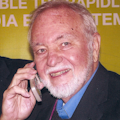Can you believe it? The BASIC programming language is 50 years old this month. As you may know, BASIC was created in 1964 by Dartmouth College professors John Kemeny and Tom Kurtz as a system to simplify the teaching of programming. BASIC means Beginner’s All-Purpose Symbolic Instruction Code. The language was implemented as an interpreter on Dartmouth’s GE time sharing mainframe where students used ASR-33 Teletype machines as terminals. It was popular from the start as students could learn the language in record time and create useful programs quickly.
Back in the 1960’s there were few programming languages. Most machines were programmed in assembler but the higher level languages FORTRAN, Algol even LISP were available yet fairly complex and difficult to master. BASIC really opened the door to computing for many because it was easy to learn.
Where is BASIC today? Well, it is still around but not as popular as it once was. Today, the C language and its derivatives seem to dominate programming. However, web development has made other languages like Java very widespread. And today, young millennials anxious to get a job in programming are spending $10,000 to $17,000 for 8 to 12 weeks of coding school where the languages taught are Python and Ruby on Rails.
I learned FORTRAN in college. Later, I learned machine code and assembler to program minicomputers like the DEC PDP-8 and PDP-11. Then when the first personal computer kits became available in the mid-1970’s, BASIC became the main language. Microsoft was formed around BASIC and was quickly successful. I ran an early paper tape version of Microsoft BASIC on an ASR-33 Teletype connected to an 8080-based IMSAI computer. It worked well. The process was to load BASIC using the 10 cps paper tape reader then do your coding. Then you stored your program on paper tape again at 10 cps. Back then there was no OS so BASIC was your way to use the computer, unless you wanted to machine code it with the front panel switches.
BASIC was the software of early personal computing. Every computer had a BASIC interpreter. Apple II, Commodore Pet, Radio Shack TRS-80, Sinclair and most others. I was at Heathkit in the 1970’s where we built the H8 and H11 computer kits. We tried to get Microsoft BASIC but they would not sell to us at a reasonable price so we developed our own called HBASIC. We also had BASIC and Focal on the DEC LSI-11 used in the H11.
There were many other versions of BASIC like CBASIC and Tiny BASIC. I can remember programming in QBASIC on an early IBM PC and using the BASIC interpreter embedded in an Intel 8052 microcontroller. More recently I used the Parallax BASIC Stamp computer for some hobby projects. It uses a very simple interpreted BASIC on a PIC microcontroller. And I taught an entry level Visual BASIC course while I was still a professor. I even learned the crazy LISP language during the artificial intelligence craze during the 1980’s.
So far I have successfully avoided using C. I tried to learn it but it is just not intuitive. It takes time and experience to get good at it. I also recently tried the derivative language of the popular Arduino computers but quickly abandoned it in favor of the BASIC Stamp for programming projects. If I have to program a microcontroller I will use BASIC if available otherwise I try to use assembler. I think best at the bit level.
Anyway, I still like BASIC and I believe it was one of the main drivers of the PC business. You don’t see it much today but it is available in many forms and still a great starting point for those interested in computers.
We should all silently thank Kemeny and Kurtz for BASIC and the computer revolution it supported.
About the Author

Lou Frenzel Blog
Communications Technology
Click here to find more of Lou's articles on Electronic Design.